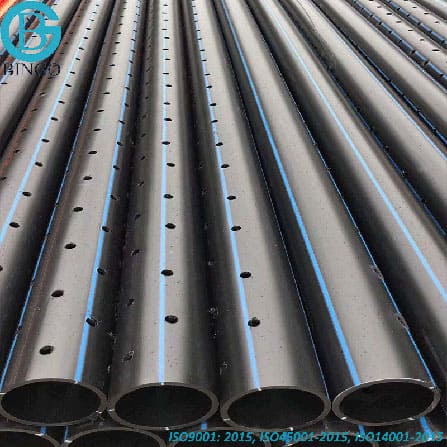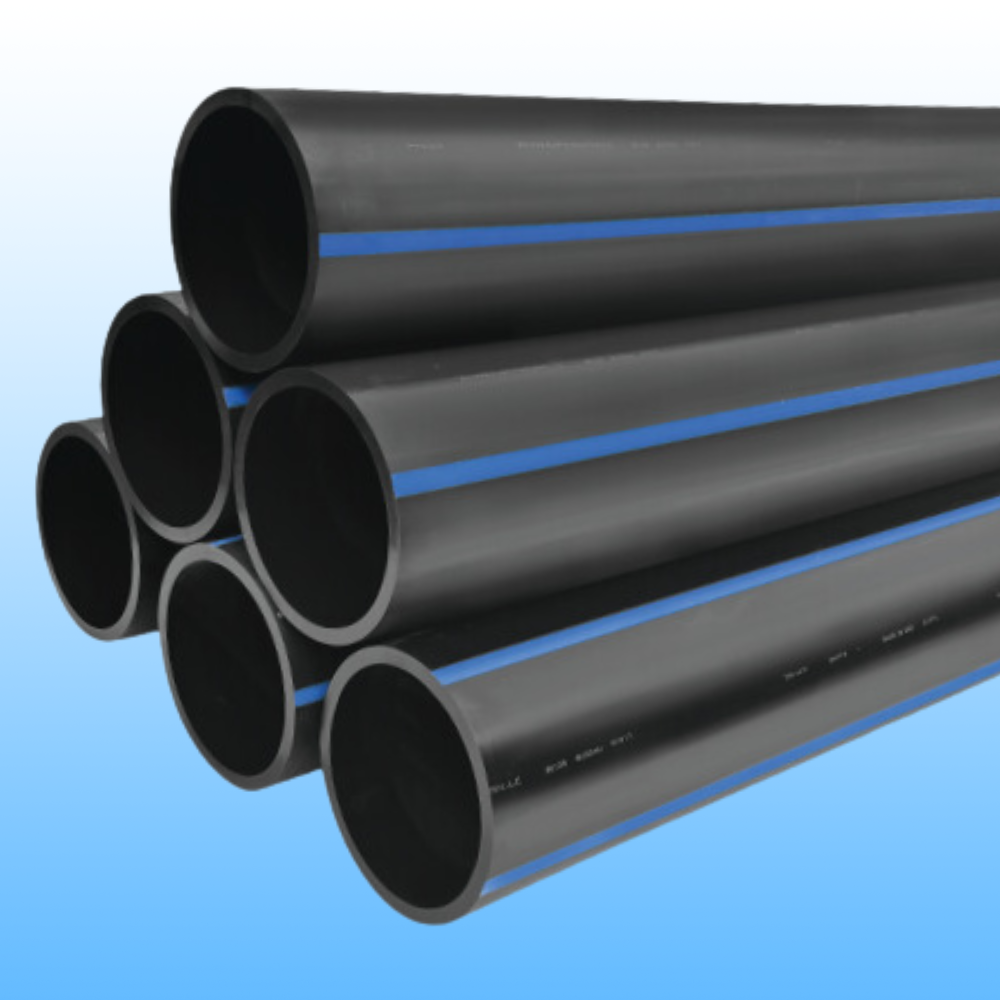hdpe pipe suppliers Midland TX: Checklist for Contractors
Wiki Article
Discover the Production Refine Behind High-Quality HDPE Pipe and Its Applications
The manufacturing process of top quality HDPE pipelines is complex and systematic. It starts with the selection of resources that improve efficiency. Following this, ethylene goes through polymerization to develop resin, which is then shaped with extrusion. Quality control is paramount, making certain that the last product fulfills stringent standards. However, the journey of HDPE pipes does not finish with manufacturing. Their applications across numerous sectors reveal a more comprehensive relevance worth checking out.Recognizing HDPE: Qualities and Advantages

High-density polyethylene (HDPE) is a functional thermoplastic understood for its toughness and resistance to numerous ecological factors. This material shows outstanding tensile stamina, making it appropriate for requiring applications. Its low-density structure adds to a light-weight item, helping with simplicity of handling and installation. HDPE additionally showcases impressive resistance to chemicals, which minimizes deterioration when revealed to rough compounds.
The material's reduced moisture absorption even more improves its long life, making it ideal for usage in pipes and tank. In addition, HDPE is resistant to ultraviolet (UV) radiation, making certain that items maintain their honesty also when revealed to sunshine. Its flexibility permits for the development of elaborate shapes without jeopardizing stamina. The green nature of HDPE, typically originated from recycled materials, contributes to its allure, advertising lasting methods in manufacturing. On the whole, these residential properties and benefits make HDPE a favored choice for numerous commercial and customer applications.
Raw Product Selection for HDPE Manufacturing
The selection of basic materials for HDPE manufacturing is important to validate the end product fulfills the wanted specs and quality criteria. High-density polyethylene (HDPE) is mostly generated from polymerized ethylene, stemmed from fossil fuels such as all-natural gas or petroleum. The high quality of these feedstocks substantially influences the mechanical and thermal residential properties of the final HDPE.Additives likewise play a substantial duty in improving HDPE's efficiency, consisting of antioxidants, UV stabilizers, and colorants, which improve toughness and resistance to environmental variables. The selection process should consider not only the chemical make-up of the raw products however additionally their handling attributes to assure efficient production.
The sourcing of raw products should prioritize sustainability and conformity with ecological guidelines, as liable practices are necessary in today's market. Inevitably, cautious basic material choice lays the structure for producing high-quality HDPE pipelines appropriate for varied applications.
The Extrusion Process: Forming HDPE Pipe
The extrusion procedure plays an essential duty in shaping HDPE pipes, beginning with careful product prep work strategies that assure perfect flow and uniformity. Just as important is the design of the die, which straight influences the last dimensions and surface top quality of the pipeline. With each other, these elements add considerably to the efficiency and quality of HDPE pipe production.Material Prep Work Techniques
Reliable production of HDPE pipelines starts with thorough product preparation strategies, particularly the extrusion procedure. Throughout this stage, high-density polyethylene material is first dried out to remove wetness, ensuring perfect circulation qualities. The resin is then fed into the extruder, where it undergoes home heating and melting, changing into a viscous state. This home heating process is meticulously managed to preserve the material's stability and efficiency. The molten HDPE is forced through a die, shaping it into a continual pipe kind. Correct temperature administration throughout extrusion is necessary, as it straight affects the product's homes and the end product quality. When shaped, the HDPE pipeline is cooled and cut to defined lengths, prepared for succeeding handling and applications.Die Design Value
Accuracy in die layout plays an essential role in the extrusion procedure of HDPE pipes. The die works as the final shaping device, directly affecting the pipe's dimensions, wall density, and surface area finish. A well-designed die guarantees uniform material flow, reducing problems such as abnormalities and weak spots. The geometry of the die need to be enhanced to fit the particular properties of HDPE, including its thickness and thermal behavior throughout extrusion. Furthermore, the cooling rate of the product as it passes with the die can markedly impact the pipeline's architectural integrity. Subsequently, investing in innovative die modern technology is crucial for suppliers aiming to generate top quality HDPE pipelines that meet market standards and consumer assumptions.Quality Assurance Measures in HDPE Production
Although different variables affect the top quality of HDPE pipeline production, effective top quality control procedures are crucial to assure consistency and integrity in the last product. Trick quality assurance methods hdpe fittings include strenuous product examination, validating that the raw polyethylene meets recognized standards for purity and density. Throughout the extrusion procedure, specifications such as temperature, stress, and cooling time are very closely checked to maintain dimensional precision and structural integrityIn addition, post-production testing is vital; makers often conduct hydrostatic tests to examine the pipeline's toughness and resistance to pressure. Aesthetic assessments for surface flaws additionally boost high quality guarantee. Accreditation from appropriate requirements organizations, like ASTM or ISO, gives an additional layer of credibility. By implementing these extensive quality assurance steps, makers can minimize flaws, boost performance, and make sure that the HDPE pipes satisfy the specific requirements of different applications, inevitably resulting in client complete satisfaction and depend on in the item.
Applications of HDPE Pipeline Across Industries
HDPE pipes are used throughout numerous markets due to their resilience and versatility. In water circulation systems, they ensure reliable delivery, while in wastewater administration, they supply reliable solutions for waste transportation. Additionally, farming irrigation networks gain from HDPE's resistance to corrosion and adaptability, making it an excellent option for modern-day farming methods.
Water Distribution Systems
A significant number of markets rely upon high-density polyethylene (HDPE) pipes for effective water distribution systems. Understood for their resilience and resistance to deterioration, HDPE pipelines are extensively made use of in metropolitan water supply networks, farming irrigation, and commercial applications. Their light-weight nature promotes easy handling and installment, minimizing labor costs and time. Additionally, HDPE pipes can suit various pressure degrees, making them appropriate for both low and high-pressure systems. hdpe pipe fittings Midland TX. The versatility of the product enables smooth integration into existing framework, minimizing the requirement for extensive excavation. Furthermore, HDPE's resistance to chemical leaching assurances that the water supplied remains risk-free and clean, making it an ideal selection for preserving the high quality of potable water throughout different sectorsWastewater Administration Solutions
Effective water distribution systems additionally lead the way for ingenious wastewater monitoring services, where high-density polyethylene (HDPE) pipelines play a substantial duty. Prominent for their resilience and resistance to rust, HDPE pipes are excellent for transferring wastewater in different setups. Their versatility permits easy setup in intricate environments, minimizing the demand for considerable excavation. In addition, HDPE's smooth interior surface area decreases rubbing, improving flow rates and efficiency. These pipelines are likewise resistant to chemical leaching, guaranteeing that pollutants do not compromise the surrounding environment. Industries, districts, and treatment facilities progressively depend on HDPE pipes for their dependability and long life, making them a favored choice for modern wastewater administration systems. This flexibility emphasizes the essential significance of HDPE pipes throughout countless applications.Agricultural Watering Networks
Agricultural irrigation networks benefit significantly from making use of high-density polyethylene (HDPE) pipelines, which offer effective and trusted water distribution to plants. HDPE discover here pipes are lightweight, making them very easy to carry and mount, while their flexibility permits numerous setups in varied surfaces. These pipes show superb resistance to corrosion, chemicals, and UV radiation, guaranteeing resilience in harsh agricultural settings. Furthermore, their smooth interior surface reduces rubbing loss, optimizing water flow and decreasing energy costs related to pumping. The longevity of HDPE pipes, often exceeding 50 years, adds to lower maintenance and replacement expenses. Consequently, farmers increasingly count on HDPE pipes to enhance irrigation effectiveness site web and advertise lasting farming methods, ultimately resulting in improved crop yields and source preservation.Future Fads in HDPE Pipe Technology
As the demand for lasting and efficient infrastructure expands, advancements in HDPE pipe technology are positioned to change various markets. Arising fads include the combination of smart innovations, such as sensing units and IoT capabilities, which promote real-time surveillance of pipeline problems, lowering maintenance expenses and avoiding leaks. Furthermore, the advancement of sophisticated manufacturing strategies, such as 3D printing, is allowing the production of complex, tailored pipe designs that provide to details task demands.In addition, the concentrate on recycling and circular economic climate methods is driving the technology of HDPE pipelines made from recycled materials, improving sustainability. Boosted jointing methods, such as electro-fusion and mechanical fittings, are likewise enhancing setup performance and reliability. Finally, the expanding emphasis on environmental guidelines is pushing manufacturers to take on greener manufacturing processes, making sure that HDPE pipes not only satisfy market requirements but likewise cultivate a more lasting future for infrastructure advancement.
Often Asked Concerns
Exactly How Does HDPE Contrast to Other Plastic Products?
HDPE outmatches many various other plastic materials relating to durability, chemical resistance, and adaptability. Its low thickness and high tensile toughness make it perfect for various applications, often surpassing options in both performance and longevity.What Are the Environmental Impacts of HDPE Manufacturing?
The ecological influences of HDPE production consist of greenhouse gas emissions, energy usage, and prospective pollution from producing processes. Furthermore, inappropriate disposal can result in dirt and water contamination, increasing problems concerning lasting eco-friendly effects.Can HDPE Pipes Be Reused?
Yes, HDPE pipelines can be reused. Lots of facilities approve utilized HDPE for processing, changing it right into new items. This recycling adds to sustainability initiatives, decreasing plastic waste while saving sources and power in the production cycle.What Is the Lifespan of HDPE Piping?

How Do Temperature Level Variants Affect HDPE Pipe Efficiency?
Temperature variations substantially influence HDPE pipe performance, influencing versatility and toughness. High temperature levels can cause softening, while reduced temperatures may create brittleness, eventually influencing the pipeline's sturdiness and viability for numerous applications in varied atmospheres.Report this wiki page